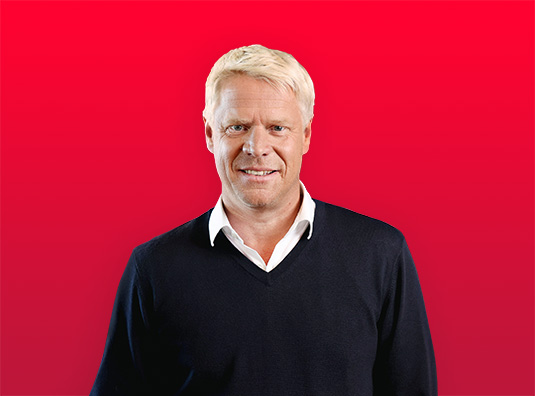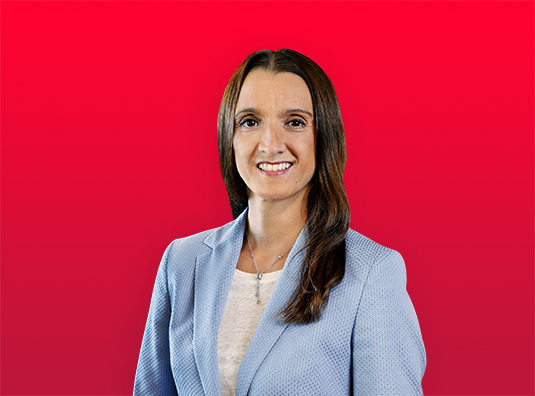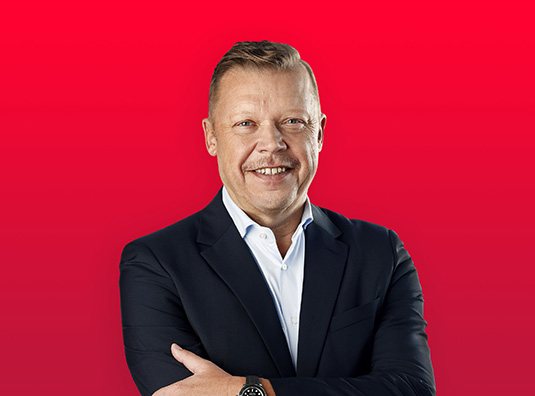Entertainment-
Strategy
Interactive graphic
- Optimization of content and playout
- More focus on expanding digital reach
- Addressing new budgets & new business
- Digitization of TV
Our Questions to
-

Content: Henrik Pabst
Appointed as Chief Content Officer and Managing Director of the Seven.One Entertainment Group in March 2020, Henrik Pabst is responsible for refining and restructuring the station group’s entire content offering for viewers and consumers across all platforms. In his ten-year tenure at ProSiebenSat.1, Pabst has held various positions, including heading up the program sales arm Red Arrow Studios International.
The Seven.One Entertainment Group is increasingly focusing on local, in-house productions, live programming and expanding relevant content. What changes has programming undergone since then?
Considering the countless content providers in the linear and digital worlds, the only way we can best the competition in winning over viewers and users in the long term is with our own content, which is available exclusively on our channels and digital platforms. For this, we need the right program and genre mix. In fall 2020, the third season of “The Masked Singer” once again delivered proof positive of our live and local content strategy’s effectiveness, with the season finale earning a 28.8-percent market share among 14- to 49-year-old viewers. The final unmasking was even watched by 51.3 percent. Over recent months, we have proven time and again that such entertainment highlights, along with many other successful formats, are our core competency. We also go above and beyond in fulfilling our responsibilities as a media company even in times of crisis. To that end, we not only integrate programming about the coronavirus into the lineup at short notice but also feature shows, such as Joko and Klaas’ high-impact “15 minutes” of air time, devoted among other things to the refugee crisis or violence against women and Thilo Mischke’s documentary “Rechts. Deutsch. Radikal.” (Right-Wing. German. Radical.). In this way, we show that by taking a clear stance, we can address many important and socially relevant issues. Looking ahead, we will continue on our path toward more live, local and relevant content. Another area we will expand and focus on is sports. I’m particularly excited about having secured the only free-TV package covering the German Bundesliga soccer matches, which will be broadcast on SAT.1 from summer 2021.
What role does “windowing” play in this content strategy?
Windowing refers to planning the distribution of our programs across platforms. We take into account both linear channels, such as our free TV stations as well as non-linear channels, such as our station websites, Joyn or external platforms including YouTube and Facebook. Here again, “The Masked Singer” is a prime example because, in addition to the show’s wide reach on ProSieben, we have built an extensive digital fan world around the format, offering users exclusive content and opportunities for interaction across all platforms. And it’s nothing short of a success. In 2020, more than 9 million votes were cast around the show via these fan worlds alone. This testifies to the fact that we have hit on the perfect mix that lets our viewers access our content with utmost ease and customization. Our aim is clear: We will always provide the perfect platforms for all our content. To maximize marketing and monetization potential, we frequently make use of all available platforms. In such instances, linear broadcasting and on-demand offerings go hand in hand. Going forward, we will further strengthen our stations’ websites, the associated fan worlds, Joyn and third-party platforms to expand our digital reach. Smart windowing is key to achieving this.
As of January 2021, the ProSiebenSat.1 production and distribution subsidiary Red Arrow Studios comes under the Entertainment segment. How does the Group benefit from this closer connection?
As a successful international content production and distribution company, Red Arrow Studios plays a very important role for us, as it gives us access to international programming content, which we can then adapt for the local German-speaking TV market. With in-house productions, we create custom-fit content for our target groups and develop the unique selling points that set us apart in the market. In 2020, we invested around one billion euros in programming, more than half of it in local content. That’s why, in many respects, it’s strategically advantageous for us to have this programming expertise within the Group. We intend to work even more closely together going forward. Our German Red Arrow subsidiary Redseven Entertainment has for many years successfully adapted shows from the Red Arrow network for us, including “Hochzeit auf den ersten Blick” (Married at First Sight) and “The Taste.”
-

Reach: Nicole Agudo Berbel
As Chief Distribution Officer and Managing Director of the Seven.One Entertainment Group, Nicole Agudo Berbel is responsible for the distribution and pay TV divisions. In this role, she is instrumental in ensuring that our content reaches viewers across the numerous distribution platforms. Over the past few years, her achievements at ProSiebenSat.1 include successfully establishing and evolving new digital products and business models for the entire free and pay TV portfolio across all distribution channels at ProSiebenSat.1, thereby generating a significant share of the Group’s revenue and earnings.
Viewers are increasingly using a variety of media in parallel. How do we continue to reach our target groups effectively?
We provide content wherever our viewers are active. To that end, we keep investing in our own platforms and ensuring they offer precision-tailored content that appeals to our target groups. Along with TV, this includes our channel websites, the channel apps, our fan worlds and, of course, our streaming platform Joyn. In addition to these own platforms, we rely on long-standing partnerships built on trust with third-party platforms (e.g. Telekom, Vodafone, HD+) and digital players such as Waipu.tv and Zattoo as well as YouTube and Facebook for short-form content. Moreover, we are entering into new partnerships – as we have done in our recent agreement with the Amazon Prime channels, which allows us to tap into new target groups for our pay TV channels.
So how exactly do we respond to changing media usage habits?
The media landscape has changed significantly in recent years. Our target groups consume content every day via different platforms and devices on a daily basis, whether in their living rooms at home or on their way to work. Sometimes in passive viewer mode , sometimes actively switching between different videos or online articles. We respond to these habits by ensuring that our viewers and users of all ages enjoy the greatest possible flexibility in accessing our content. Consuming both linear TV and our on-demand offerings or highlight clips should only ever be a click away. Thanks to digital technologies and our agreements with distribution platforms, we are able to efficiently combine and serve linear and non-linear content. That means our viewers and users can consume our TV station programming and digital products on virtually all applicable platforms. Plus, the instant restart function and our media libraries open the door to a wide range of content from our program, whenever and wherever.
How does distribution benefit marketing now that both areas operate under one roof?
Our digital and linear distribution channels are the cornerstone of our marketing because our proprietary and partnership secure us high reach and open up potential for digital forms of marketing such as addressable TV. Ultimately, this is one of the most compelling arguments in marketing. In addition, our apps or media library content on smart TVs, for example, offer further digital monetization potential. Integrating the content distribution and windowing strategies and combining them with marketing initiatives has ensured that the business areas now dovetail perfectly. After all, there is growing demand among our advertising customers for comprehensive, 360-degree TV and digital concepts. In this way, we can fully respond to their needs.
-

Monetization: Thomas Wagner
Chief Sales Officer Thomas Wagner oversees the sales business at the Seven.One Entertainment Group. In this role, he is principally responsible for the agency business. With more than 20 years as part of the Group coupled with a long tenure as Chairman of Seven.One Media, which is the leading advertising slot marketer for audiovisual and digital media in the German-speaking countries, Wagner is one of the most experienced experts in the sales business.
Restrictions to control the spread of COVID-19 presented advertisers with significant challenges in 2020. How has the Seven.One Entertainment Group supported its customers during this time?
Of course, the pandemic impacted our advertising bookings: Our customers frequently had to revisit their plans. We offered advice on rethinking campaigns whose original form or tone of voice were no longer appropriate due to lockdown – for instance by reproducing or adaption of spots. Thanks to the synergies within the Group, we were able to deliver suitable, high-reach solutions very quickly. Additionally, we ensured that customers now have even greater flexibility when booking advertising space. Of course, these measures are based on our research into increased media usage during the COVID-19 pandemic. All in all, this got us through the crisis on a strong footing – and we could proof that TV is still the most effective advertising medium. To stay in contact with our advertising partners over a distance, we launch new digital dialog formats for our partners both on agency and client side. One thing became clear quickly: the even closer dialogue with our customers was and still remains vitally important.
There’s nothing more powerful than digitalization in shaping our use of media. What does this mean for sales?
TV is becoming increasingly digital. We combine our stations’ extensive reach with targeting as we see it in the digital world. This approach not only allows us to outgrow the boundaries between linear and digital products but also to harness the reach generated by all aspects of our TV shows in advancing our customers’ cross-platform campaigns. Therefore, we are developing innovative advertising solutions. We continue to invest intensively in our range of targeting options and are increasingly facilitating programmatic bookings – even on TV. Our CrossDevice Bridge , which we launched in 2020, makes this possible. For the first time, we can serve TV and digital advertising campaigns across all devices. Most importantly of all: by adding advantages such as reach and addressability, we are taking TV as an advertising medium to a completely new level.
Direct comparisons between TV and digital advertising remain a bugbear in sales. How do you succeed not only in creating integrated offerings – but also in measuring their effects?
Wide reach in high-value environments is becoming increasingly valuable to marketers – and TV remains the best way of addressing end customers quickly and effectively. At the end of the day, it is all about impact. With the additional touchpoints provided by our digital offerings, we connect with viewers where they are most comfortable. By that, they come into contact with our clients’ products in more ways. Of course, it is then up to us to ensure that the reach of these measures can be compared on a one-to-one basis. This is why establishing a video currency that is not only applicable across all platforms but also based on established measuring models, such as those employed by the Arbeitsgemeinschaft Videoforschung (Germany’s television research working group – AGF), is a top priority for us and the market. We must harness comprehensive reach across all channels and precision-targeted sales to persuade our clients that viewers are fully seeing their advertising in all media – not just on linear TV. With the launch of CFlight, we are partnering with Sky to establish transparent criteria for cross-media campaigns. Advertising exposures that meet the CFlight criteria are the gold standard. This makes it possible to compare cross-media reach for the first time. All this builds the base for our “Total Video” product. Even without all that, we are able to execute creative end-to-end campaigns that combine TV with digital. A good example is the campaigns we served as part of our successful “The Masked Singer” show. Together with our partners, such as Opel, we created a fantastic advertising environment across various channels – from TV through digital fan worlds to social media.